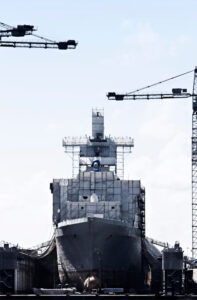Prior to the early 1980s, crane operators could have been exposed to asbestos (a cancer-causing substance) in many ways. Crane operators often worked on job sites that used asbestos products, and their work may have sent asbestos fibers flying into the air. Thankfully, crane operators with mesothelioma (an asbestos-caused cancer) may qualify for medical and financial aid.
Mesothelioma and Crane Operators Explained
Both military and civilian crane operators who were exposed to asbestos before the early 1980s might be diagnosed with mesothelioma today. Mesothelioma is a rare but deadly type of cancer that occurs after inhaling or ingesting asbestos fibers.
 Crane operators played a major role in building new structures, ships, and roads, as well as demolishing old ones. However, before the early 1980s, most ships, buildings, and construction materials used asbestos, as the dangers of this substance weren't widely known.
Crane operators played a major role in building new structures, ships, and roads, as well as demolishing old ones. However, before the early 1980s, most ships, buildings, and construction materials used asbestos, as the dangers of this substance weren't widely known.
High-risk job sites for crane operators include:
- Construction sites
- Demolition sites
- Highway construction
- Railroad construction
- Renovation jobs
- Shipyards
- Steel and iron mills
It usually takes 10-50 years after asbestos exposure for mesothelioma symptoms to show. Fortunately, crane operators with mesothelioma might qualify for medical and financial aid. Get a Free Veterans Packet to learn more.
How Were Crane Operators Exposed to Asbestos?
Asbestos was widely used in building materials until the early 1980s, so crane operators were very likely exposed as they helped build, renovate, or demolish structures. All of these activities could release asbestos fibers into the air.
Further, many cranes had brakes lined with asbestos. Crane control panels also had arc chutes that used asbestos. Asbestos fibers could have entered the air nearby as these materials wore out.
As soon as asbestos is disturbed, thousands of tiny fibers become airborne and can be inhaled by crane operators and anyone nearby. These fibers could penetrate the lining of the lungs, abdomen, or heart in the process, leading to mesothelioma 10-50 years later.
Crane operators usually worked in open cabs, and very few had filtration systems to allow fresh air to circulate. Even those perched high up in the sky were at risk of unknowingly inhaling fibers carried through the air by dust.
Today, far more safety procedures are in place, and crane operators wear protective face masks and clothing to prevent contact with asbestos.
Crane Operators in the Military
During World War II and through the early 1980s, asbestos was widely used by the U.S.

Asbestos was used to make military bases, U.S. Navy ships, and vehicles more durable and fireproof. Crane operators often built, renovated, or demolished these structures.
Further, those who worked as crane operators during military service may have gone on to work in similar civilian jobs once they were discharged. Unfortunately, this may have meant even more exposure.
If you or a loved one developed mesothelioma after serving in the military, we can help you access VA benefits. See how right now.
Crane Operators at Ground Zero
Many crane operators who worked to remove the remains of the World Trade Center after the September 11th, 2001 bombings were unknowingly exposed to asbestos fibers, which came from the walls of the fallen buildings.
Many first responders and those who worked in the aftermath of 9/11 have gone on to develop cancers like mesothelioma, in part due to inhaling asbestos fibers and other toxic debris in the air at Ground Zero.
Secondhand Asbestos Exposure and Crane Operators
Crane operators weren't the only ones at risk of asbestos exposure and mesothelioma. The fibers could also get attached to crane operators' clothing, hair, and shoes. This meant they could have unknowingly taken the fibers home and exposed their family members.
Many wives and children of crane operators and others who worked with or around asbestos have gone on to develop mesothelioma due to this secondhand exposure.
Benefits for Crane Operators With Mesothelioma
Crane operators — and anyone else exposed to asbestos before the risks were well-known — deserve help if they now have mesothelioma.
Fortunately, crane operators with mesothelioma may qualify for a wide range of medical and financial benefits.
Crane operators can get benefits through:
Mesothelioma Lawsuits
A mesothelioma claim allows crane operators to demand compensation from the makers of asbestos-containing products. These manufacturers knew the risks of asbestos but concealed them to make a profit.
The average mesothelioma claim awards $1 million or more and can be used for anything, including medical expenses, basic living costs, and other bills.
Learn more about filing an asbestos claim (also known as a mesothelioma lawsuit) by calling our team now at (877) 450-8973. No legal action is taken against the U.S. military.
VA Benefits
Crane operators who served in the U.S. military and were later diagnosed with mesothelioma may qualify for benefits from the U.S. Department of Veterans Affairs (VA).
These benefits include monthly financial compensation worth almost $4,000 a month in many cases, as well as free or low-cost medical treatment through the VA's health insurance plan.
Learn how mesothelioma VA benefits can help you in our Free Veterans Packet.
Asbestos Trust Funds
Some manufacturers of asbestos-based products created trust funds (which allow them to pay those who were harmed without dealing with lawsuits).
More than $30 billion is currently available in asbestos trust funds. An attorney can help you and your family file claims and get financial aid.
File an asbestos trust fund claim right now.
Help for Crane Operators With Mesothelioma
Crane operators with mesothelioma and other asbestos-related diseases deserve the best financial and medical help possible. This is true for both crane operators who served our country as well as civilians.
The Mesothelioma Veterans Center is here to help affected crane operators, and their loved ones get all the benefits they deserve.
Qualifying crane operators with mesothelioma can access life-changing financial compensation and medical help.
Get started right now with our Free Veterans Packet.
Crane Operators and Mesothelioma FAQs
How many construction workers get mesothelioma?
Thousands of military and civilian construction workers have developed mesothelioma, including crane operators.
Construction sites relied on asbestos-containing materials for 10-50 years, and the health risks weren't fully understood because manufacturers of these materials concealed the truth to make a profit.
Are crane operators at risk of other asbestos-related diseases?
Yes. Asbestos exposure can cause many diseases, not just mesothelioma.
Because of this, crane operators exposed to asbestos could develop lung cancer, asbestosis, and other asbestos-related diseases later in life.
If you've been diagnosed with an asbestos-related disease after serving as a crane operator, contact us to get help.
Why are crane operators at risk of mesothelioma?
Crane operators are in danger of mesothelioma because they often had to build and destroy structures that contained asbestos. These activities sent asbestos fibers flying into the air that they breathed.
Asbestos is the only known cause of mesothelioma. Before the early 1980s, the risks of asbestos were hidden from the public by major corporations.
As a result, crane operators and many other workers were exposed without knowing asbestos could cause cancer.
How much asbestos exposure causes mesothelioma?
There is no safe level of asbestos exposure. This means crane operators who were exposed even just once could develop mesothelioma 10-50 years later.
That said, those at the highest risk worked with asbestos-containing products on a daily basis for long periods of time (months or years).
Call (877) 450-8973 to learn about benefits, treatments, and compensation options that you may qualify for if you worked as a crane operator and now have mesothelioma.
What benefits are available to crane operators with mesothelioma?
Crane operators may qualify for financial benefits (including payouts worth over $1 million), medical care, and more if they now have mesothelioma.
Further, crane operators who served their country can qualify for additional benefits through the VA.
Get a Free Veterans Packet to learn about the benefits you might qualify for.


